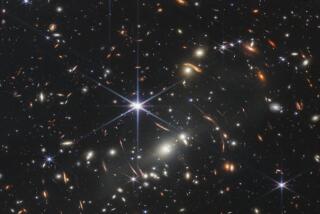Astronomers found a planet where life might thrive, and itâs just 31 light-years away
The discovery of a super-scorched planet orbiting around a dim, nearby star has helped reveal the presence of two more previously unseen planets â one of which could host liquid water and thus be friendly to life, astronomers say.
The finds, discussed in a paper in the journal Astronomy & Astrophysics and another in Astrophysical Journal Letters, present a tantalizing opportunity in the search for alien worlds with the potential to harbor life, scientists said.
Their excitement was focused on a potentially rocky super-Earth planet in the zone where liquid water could be stable on the surface.
âIf it turns out to be a transiting planet, itâs the closest transiting potential habitable world,â said Lisa Kaltenegger, an astrophysicist and director of the Carl Sagan Institute at Cornell University who led one of the studies, which modeled the planetâs possible characteristics. âItâs an amazing target.â
It all started with a blistering planet known as GJ 357 b that was picked out by NASAâs Transiting Exoplanet Survey Satellite, or TESS. Located about 31 light-years away in the constellation Hydra, itâs a little more than 1.2 times the size of Earth and 1.8 times as massive. It circles its star every 3.9 days â tracing an orbit thatâs 11 times closer to its star than Mercuryâs is to our sun.
Even though its M-dwarf star is roughly 40% cooler than our sun, the planet is in all likelihood searingly hot â probably 490 degrees Fahrenheit or so â even without the insulating effects of an atmosphere.

It was first spotted in February by TESS, which methodically scans the skies looking for dips in a starâs light that might indicate that a planet is passing, or transiting, in front of it. Astronomers then confirmed its existence using information from ground-based telescope.
In the process, they saw hints that an additional pair of planets were also circling the same star.
These two planets, GJ 357 c and d, were found using the radial velocity method, which looks for the slight wobble in the starâs motions caused by its planetsâ tiny gravitational tugs.
âTESS prompted us to discover hidden treasure ... that we might not have if TESS hadnât pointed the flashlight there,â said Johanna Teske, an astronomer at the Carnegie Observatories in Pasadena who was involved with the planetary discoveries.
GJ 357 c weighs in at about 3.4 times Earthâs mass, if not more, and orbits the star every 9.1 days at a distance more than double that of GJ 357 b. This proximity keeps the temperature at around 260 degrees Fahrenheit â not quite as singed as planet b, but still pretty toasty.
Itâs the third planet, GJ 357 d, that holds some potential as a habitable world.
It weighs at least 6.1 Earth masses and circles the star at a much greater distance, completing an orbit in 55.7 days. Even though this is just one-fifth the distance of the Earth to our sun, GJ 357 dâs dim star leaves the surface very cold. Without an atmosphere, the thermometer at the surface would hover around 64 degrees Fahrenheit below zero â meaning no liquid water on the surface.
However, if GJ 357 d has an atmosphere, this could be a game changer, the researchers said.
A dense atmosphere with the right composition could trap some warmth and allow water to remain liquid on the planetâs surface. That would be similar to an ancient version of Mars. Although the red planet is frigid and dry today, scientists think it once had a thick atmosphere that allowed liquid water to leave marks all over its ruddy face.
Keep in mind, Mars is quite small, Kaltenegger said. Our rust-hued neighbor comes in at barely over half the size and a tenth the mass of Earth. In contrast, GJ 357 d is more than six times as massive â and if it turns out to be rocky, it could be roughly 1.7 times as big.
With all that mass, it seems likely that such a planet would have an atmosphere, she said.
The trick, the scientists said, would be to try to catch a glimpse of GJ 357 d â if it can be seen transiting its star from our vantage point.
If GJ 357 d can indeed be spotted, researchers should one day be able to analyze its atmosphere to look for life-friendly chemicals. But that work may have to wait for more powerful ground telescopes or spacecraft like NASAâs James Webb Space Telescope, planned for launch in 2021, the scientists said.






